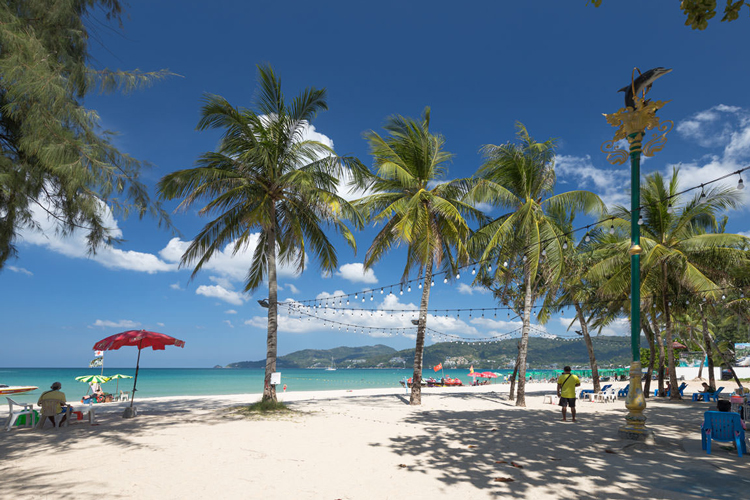Phuket

Phuket, often referred to as the "Pearl of the Andaman", is Thailand's largest island and a popular tourist destination. Situated in the Andaman Sea off Thailand's west coast, Phuket is connected to the mainland by the Sarasin Bridge. Known for its diverse geography, Phuket features lush mountains, rainforests, and beautiful coastline. The western coast is famous for its stunning beaches, while the interior offers scenic landscapes. Phuket boasts numerous world-renowned beaches, including Patong Beach, Karon Beach, Kata Beach, and Surin Beach. Phuket provides a range of accommodations, dining options, and transportation services to cater to the needs of diverse travelers. Let's admire the beauty of Phuket with Asia King Travel!
Phuket's historical narrative is intricately woven with the Srivijaya Kingdom, a prominent maritime empire in Southeast Asia. Once a pivotal trading hub and a crucial layover for merchants and explorers, the region witnessed the dominance of the Sultanate of Ligor (present-day Nakhon Si Thammarat) in the 13th century, renowned for its vibrant trade and fishing activities. Transitioning into the 19th century, Phuket became an integral part of the Kingdom of Siam (modern Thailand) through the Bowring Treaty with the British, maintaining its status as a thriving commercial and fishing center.

A summer day at Patong beach
The initiation of Phuket's journey as a tourist hotspot unfolded in the latter part of the 20th century, leveraging the province's natural allure, featuring limestone formations, pristine beaches, and diverse marine ecosystems, captivating global travelers. The 1980s and 1990s witnessed a remarkable surge in tourism, notably with the development of sought-after locales like Ao Nang, Railay Beach, and the Phi Phi Islands. Phuket emerged as a premier destination for nature enthusiasts, rock climbers, and beach aficionados.
Phuket's historical tapestry comprises ancient civilizations, cultural imprints, and the contemporary evolution of a beloved tourist haven. Its enduring natural beauty and cultural legacy persist in making Phuket a compelling realm to explore and cherish.
The best season to visit Phuket for most travelers is during the dry season, which runs from November to April. This period offers favorable weather conditions, making it ideal for various outdoor activities and beach-related pursuits.
During the dry season, visitors can enjoy sunshine, clear waters, and a variety of outdoor adventures. This is the high tourist season, so it's advisable to plan and book accommodations in advance.

Big Buddha Temple - symbol of peace and solidarity, intended to bring luck to the island
While the wet season (May to October) sees more rainfall, it's still possible to visit during this time. Prices are lower, and the landscape is lush and green, but be prepared for occasional heavy showers.
Ultimately, the best time to go to Phuket depends on your preferences and tolerance for weather conditions. If you prioritize sunny days and beach activities, the dry season is recommended. If you prefer budget-friendly travel and don't mind occasional rain, the wet season can offer a unique experience with fewer crowds.
.jpg)
The scenery seen from Karon viewpoint is picturesque
Discovering the vicinity of Phuket provides a range of transportation alternatives. Here are various methods you can utilize to explore nearby attractions:
Taxi Services: Taxis are easily accessible in Phuket, and you can hire them for both short journeys and full-day explorations. It's essential to establish the fare beforehand.
Scooter or Motorbike Rentals: Renting a scooter or motorbike is a popular choice for self-guided exploration. Ensure you wear a helmet and understand the rental terms and fuel policies.
Car Rentals: Opting for a car rental offers the freedom to explore at your own pace. Numerous car rental agencies operate in Phuket, providing a diverse range of vehicles.
Tuk-tuks: Tuk-tuks, three-wheeled vehicles commonly used for short-distance travel, are available. It's advisable to negotiate the fare before commencing your journey.
Songthaews: Songthaews, shared minivans or pickups converted for passenger transport, follow predetermined routes and offer a cost-effective transportation option.
Boat Tours: Many nearby islands and attractions are accessible through boat tours, which often include transportation, guided services, and various activities.
Public Buses: Public buses connect different areas of Phuket and provide an economical option. However, they may not be the most convenient for reaching specific tourist destinations.
Walking and Cycling: Exploring on foot or by bicycle is suitable for areas with pedestrian-friendly paths. Some attractions may be within walking or cycling distance.
You may like: Check-in top 7 most wonderful beaches in Thailand.
Enjoy Thailand's splendor and thrills with our "Phuket Tour 7 Days: Unforgettabl...
With our "Phuket Tour 6 Days 5 Nights: Exciting Destinations ", which combines c...
Experience the beauty of Thailand with our "Phuket Tour 5 Days 4 Nights". Discov...
Uncover the magic of Phuket on our Phuket Tour 4 Days 3 Nights. From pristine be...
Discover the enchanting beauty of Thailand with our Phuket Phang Nga Tour 3 Days...
Experience serene island life at Koh Yao Yai Tour 3 Days with lobster feasts, el...
Discover the charm of Koh Yao Yai Island Tour 3 Days with a village tour, lobste...